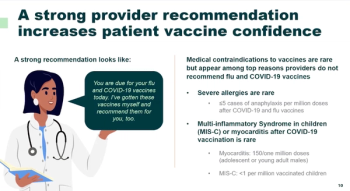
Flu season less severe than last
H1N1 is the most prevalent flu virus circulating this year, resulting in a less severe flu season overall than last year when H3N2 was predominant.
The flu season is far from over, but things are looking much better than last year, overall.
It’s estimated that between 20.4 million and 23.6 million Americans have been sickened by the flu since October 2018, and that between 9.5 million and 11.1 million have required medical care with roughly 250,000 to 300,000 needing hospitalization, according to the most recent figures from the CDC.
Preliminary data also reveals that the flu has resulted in between 16,400 and 26,700 deaths this year. These figures are not exact, the CDC noted, but an estimate of cumulative burden calculated by a formula based on rates of laboratory-confirmed influenza-associated hospitalizations. This is the first year CDC has released such estimates during the flu season.
Joshua Doyle, MD, PhD, a member of the CDC’s Epidemic Intelligence Service, said last year was an unusually severe flu season, and indicators so far for this year show a much lower severity year, mainly due to the type of virus that is circulating and how well the vaccine is working.
During the
Brendan Flannery, PhD, a lead investigator for the U.S. Flu Vaccine Effectiveness Network, said H1N1 appears to be the predominant virus circulating this year, which could account for the lower severity. H3N2 was the predominant virus in 2017-18 and, while the vaccine was a good match for H3N2 last year, he said H3N2 viruses mutate when grown to be used in vaccines and those mutations can affect the efficacy of the vaccine.
“That can especially be a problem in H3N2 years, but it’s not so much a problem with H1N1,” Flannery said.
Additionally, H3N2 hits older adults harder, Flannery said, raising the severity of the flu season overall last year compared to this year where H1N1 is more prevalent.
“What we’re seeing is that with the H1N2 virus, it can still be severe, but rates are lower in older adults,” Flannery said. “But the number of deaths this year is still a reminder that even in less severe years, there is a risk of mortality. The number of death this year is a reminder that even if less severe years, there is still a risk of mortality.”
In the Feb. 15
As to when the flu season will end, Doyle said that remains to be seen.
“We are in the middle of the season right now, and it’s hard to predict how much longer we’ll see flu activity,” he said.
Flu activity is at a high for the season across the country right now, Doyle said, offering the reminder that it’s still not too late to get a flu shot. Immune responses take 10 days to two weeks to mount, but Doyle said that would be enough to offer protection through the end of flu season.
Newsletter
Stay informed and empowered with Medical Economics enewsletter, delivering expert insights, financial strategies, practice management tips and technology trends — tailored for today’s physicians.








